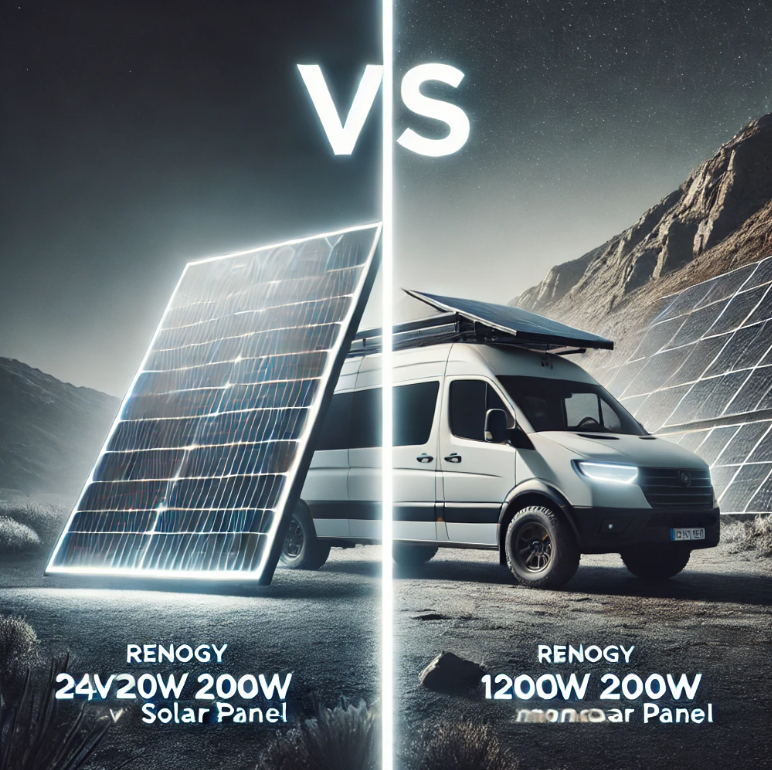Renogy 16BB N-Type 200 Watt 24V Solar Panel Vs. 200 Watt 12 Volt Monocrystalline Solar Panel
🆚 Renogy 16BB N-Type 200W 24V Solar Panel vs. 200W 12V Monocrystalline Solar Panel
Off-Grid Solar Panel Comparison for Vanlife, Overlanding & Mobile Power Systems
When choosing the right solar panel for your Sprinter van, overland rig, or off-grid build, panel voltage, efficiency, and wiring flexibility all come into play. Here’s a side-by-side comparison of two top-tier 200W panels from Renogy, built to power your adventures.
🏁 Bottom Line — Which Should You Choose?
At Northwest-Overland.com, we recommend the Renogy 200W 24V N-Type Panel for most modern off-grid and van conversion setups. It offers better efficiency, longer lifespan, and simplifies your system wiring — especially when paired with a Victron MPPT 100V – 30AMP charge controller.
Remember, size does Matter as these Panels have different dimensions. You will need Panels that will fit your configuration.
However, if you’re building a simpler system or already committed to 12V panels, the 200W 12V monocrystalline remains a solid performer.

⚙️ Quick Specs Overview
| Feature | Renogy 200W N-Type 24V (16BB) | Renogy 200W Monocrystalline 12V |
|---|---|---|
| Nominal Voltage | 24V | 12V |
| Maximum Power (Pmax) | 200W | 200W |
| Operating Voltage (Vmp) | ~31V | 19.2V |
| Operating Current (Imp) | ~6.45A | 10.42A |
| Open Circuit Voltage (Voc) | ~37.5V | 23.0V |
| Short Circuit Current (Isc) | ~6.85A | 11.05A |
| Module Efficiency | ~20.7% (N-Type) | 19.2% |
| Panel Size (L × W × H) | Smaller footprint | Slightly larger |
| Ideal MPPT Pairing | Victron 100/30 or 100/50 | Victron 75/15 or 100/30 |
🔋 Performance & Efficiency
- N-Type 16BB (24V) panels use advanced cell technology for higher efficiency and better performance in low-light and high-temperature conditions. N-type cells are also more resistant to degradation over time (LID – Light Induced Degradation).
- The 12V Monocrystalline panel is a solid, reliable option and pairs well with smaller MPPTs, but its lower voltage and higher current result in more wiring loss and bulkier cable requirements.
✅ Winner: N-Type 24V Panel — more efficient, better thermal performance, modern tech.
🔌 Wiring & Installation
- 24V Panels (in series) deliver higher voltage and lower current — this means less voltage drop, smaller wire gauge, and easier cable management over longer runs.
- 12V Panels (in parallel) produce higher current — this can require thicker cables, fuses rated for higher amperage, and introduces more wiring complexity if expanding later.
✅ Winner: 24V Panel — cleaner, more scalable wiring.
🧰 System Compatibility
- 24V N-Type panels are ideal for both 12V and 24V battery systems when used with MPPT controllers like the Victron SmartSolar 100/30 or 100/50, which efficiently down-convert higher solar voltages.
- 12V panels can be more plug-and-play for smaller setups but are less ideal for series configurations and expandability.
✅ Winner: 24V Panel, especially for Victron-based builds and future expansion.
🧭 Best Use Case
- 24V N-Type Panel: Ideal for overlanders, vanlifers, and off-grid builders who want efficient, scalable, modern solar with better performance over time.
- 12V Monocrystalline Panel: Great for smaller, budget-conscious builds or replacing panels in an existing 12V-only setup.
🏁 Bottom Line — Which Should You Choose?
At Northwest-Overland.com, we recommend the Renogy 200W 24V N-Type Panel for most modern off-grid and van conversion setups. It offers better efficiency, longer lifespan, and simplifies your system wiring — especially when paired with a Victron MPPT charge controller.
However, if you’re building a simpler system or already committed to 12V panels, the 200W 12V monocrystalline remains a solid performer.
🔗 Need help choosing panels or MPPT controllers for your build?
Contact us at Northwest-Overland.com — we’ll guide you every step of the way.




